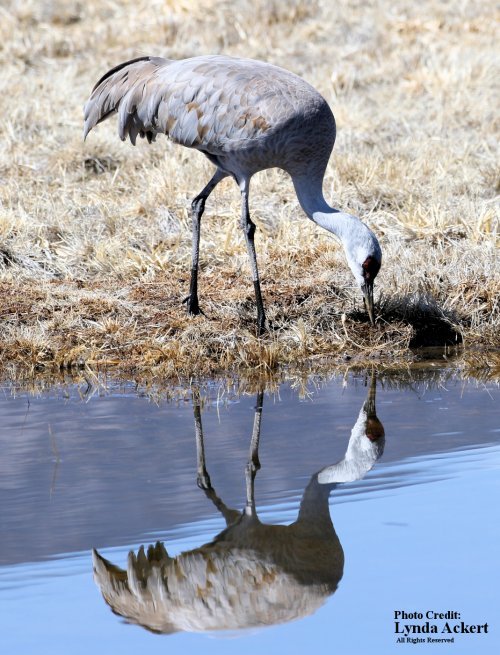| Scientific classification | |
|---|---|
| Kingdom: | Animalia |
| Phylum: | Chordata |
| Class: | Aves |
| Order: | Gruiformes |
| Family: | Gruidae |
| Genus: | Antigone |
| Binomial Name | Antigone canadensis |
Whether stepping singly across a wet meadow or filling the sky by the hundreds and thousands, Sandhill Cranes have an elegance that draws attention. These tall, gray-bodied, crimson-capped birds breed in open wetlands, fields, and prairies across North America. They group together in great numbers, filling the air with distinctive rolling cries. Mates display to each other with exuberant dances that retain a gangly grace. Sandhill Crane populations are generally strong, but isolated populations in Mississippi and Cuba are endangered.
Migratory subspecies of sandhill cranes breed in the Northern U.S., Canada, Alaska, and Siberia. Each winter they undertake long southern journeys to wintering grounds in Florida, Texas, Utah, Mexico, and California. En route, more than three-fourths of all sandhill cranes use migratory staging areas in a single 75-mile stretch along Nebraska’s Platte River.

Diet
Most sandhill cranes live in freshwater wetlands. They are opportunistic eaters that enjoy plants, grains, mice, snakes, insects, or worms.
Reproduction
During mating, pairs vocalize in a behavior known as “unison calling.” They throw their heads back and unleash a passionate duet—an extended litany of coordinated song. Cranes also dance, run, leap high in the air and otherwise cavort around—not only during mating but all year long.
Sandhill cranes raise one brood per year. In nonmigratory populations, laying begins between December and August. In migratory populations, laying usually begins in April or May. Both members of a breeding pair build the nest using plant material from the surrounding area. Nest sites are usually marshes, bogs, or swales, though occasionally on dry land. Females lay one to three (usually two) oval, dull brown eggs with reddish markings. Both parents incubate the eggs for about 30 days. The chicks are precocial; they hatch covered in down, with their eyes open, and able to leave the nest within a day. The parents brood the chicks for up to three weeks after hatching, feeding them intensively for the first few weeks, then gradually less frequently until they reach independence at 9 to 10 months old.
The chicks remain with their parents until one to two months before the parents lay the next clutch of eggs the following year, remaining with them 10–12 months. After leaving their parents, the chicks form nomadic flocks with other juveniles and nonbreeders. They remain in these flocks until they form breeding pairs between two and seven years old.
Subspecies
Six subspecies have been recognized in recent times, including:
- Lesser sandhill crane, A. c. canadensis
- Cuban sandhill crane, A. c. nesiotes
- Florida sandhill crane, A. c. pratensis
- Mississippi sandhill crane, A. c. pulla
- Canadian sandhill crane, A. c. rowani
- Greater sandhill crane, A. c. tabida
Behavior
Sandhill cranes are fairly social birds that usually live in pairs or family groups through the year. During migration and winter, unrelated cranes come together to form “survival groups” that forage and roost together.
Cool Facts
- The Sandhill Crane’s call is a loud, rolling, trumpeting sound whose unique tone is a product of anatomy: Sandhill Cranes have long tracheas (windpipes) that coil into the sternum and help the sound develop a lower pitch and harmonics that add richness.
- Sandhill Cranes are known for their dancing skills. Courting cranes stretch their wings, pump their heads, bow, and leap into the air in a graceful and energetic dance.
- The elegance of cranes has inspired people in cultures all over the world—including the great scientist, conservationist, and nature writer Aldo Leopold, who wrote of their “nobility, won in the march of aeons.”
- Although some start breeding at two years of age, Sandhill Cranes may reach the age of seven before breeding. They mate for life—which can mean two decades or more—and stay with their mates year-round. Juveniles stick close by their parents for 9 or 10 months after hatching.
- The earliest Sandhill Crane fossil, estimated to be 2.5 million years old, was unearthed in the Macasphalt Shell Pit in Florida.
- Sandhill Crane chicks can leave the nest within 8 hours of hatching, and are even capable of swimming.
- The oldest Sandhill Crane on record was at least 36 years, 7 months old. Originally banded in Wyoming in 1973, it was found in New Mexico in 2010.



The above images were taken at Monte Vista National Wildlife Refuge in Colorado during spring migration, March 2021. (Photo Credit: Lynda Ackert – All Rights Reserved)
Product Suggestion
Sandhill Crane | Notebooking Pages
Students can use these pages to produce a beautiful report or project on these magnificent birds! Includes 5 notebooking pages (one with a North American map) and 1 coloring page.
My Teaching Library has a variety of other notebooking pages for birds! Here are a few:
________________________



